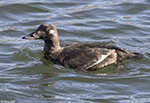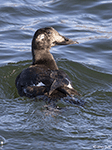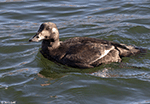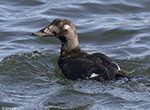| Length: 20 to 24 inches | Wingspan: 34 to 40 inches | Seasonality: Rare Visitor |
| ID Keys: White wing patch visible in flight, white teardrop on eye (male), dark body | ||
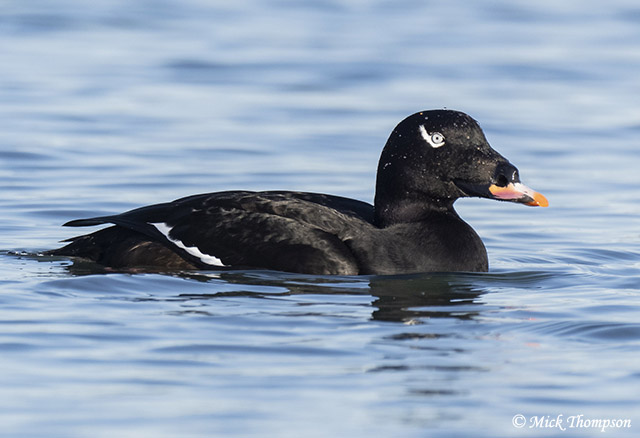 The White-winged Scoter, the largest of the Scoters, is also the
Scoter most likely to be found in South Dakota. The white wing patch that
gives the species its name is sometimes hidden while swimming, but is very
visible in flight. Although they breed on freshwater lakes, ponds, and
rivers of Canada and Alaska, they primarily migrate to coastal habitats for the
winter. Small flocks of White-winged scoters tend to follow river systems as
they move towards the coast, a behavior the sometimes leads to their presence in
South Dakota in the fall as they follow the Missouri River system.
The White-winged Scoter, the largest of the Scoters, is also the
Scoter most likely to be found in South Dakota. The white wing patch that
gives the species its name is sometimes hidden while swimming, but is very
visible in flight. Although they breed on freshwater lakes, ponds, and
rivers of Canada and Alaska, they primarily migrate to coastal habitats for the
winter. Small flocks of White-winged scoters tend to follow river systems as
they move towards the coast, a behavior the sometimes leads to their presence in
South Dakota in the fall as they follow the Missouri River system.
Habitat:
In summer, White-winged Scoters can be found in a variety of aquatic habitats, but most typically near lakes surrounded by forest and brushy undergrowth that they used for breeding. They will also sometimes use more open country provided protected locations are available for constructing nests. In winter, they are primarily found along coastal waters, with some on the Great Lakes and other large inland water bodies.
Diet:
Primarily feeds on mollusks. White-winged scoters will also feed on feed on crustaceans (including crawfish in their visits to South Dakota), small fish, small amphibians, aquatic insects and their larvae, and some aquatic plants. Their love of mollusks make them one of the few species that may be benefitting from the invasive Zebra Mussel in the Great Lakes. Wintering White-winged Scoter numbers were in decline on the Great Lakes, but with the abundant new food source, their numbers seem to be rising there again in winter.
Behavior:
White-winged Scoters dive underwater to forage, propelling itself by its feet. Outside of the breeding season White-winged Scoters are gregarious, migrating, foraging, and over-wintering in small to moderately sized flocks that may also include other scoter species.
Breeding:
Non-breeder in South Dakota. During the breeding season, courtship typically begins before they even arrive on their breeding grounds. Birds in migration will typically begin courtship rituals that include a cooperative flight display, with males and typically, a smaller number of accompanying females, flying upward together before stopping and allowing themselves to fall back down towards the Earth. On the water, males raise their back and lower their head, paddling furiously and rushing at rivals. They may also chase females above and below the water.
Upon arriving on their breeding grounds, females select a nest site that's typically hear a water source, in a protected area such as the base of a dense shrub or other vegetation. They scrape a shallow depression, and then build a nest of grasses, weed stems, and feathers. She lays 6 to 12 creamy light pink or light tannish colored eggs, and she alone incubates them. The young hatch after about 25-29 days, and leave the nest within hours of hatching. The female tends to the young and protects them, but the young feed themselves.
Song:
Often silent, but both sexes will sometimes give a high whistling note in courtship. When disturbed, females will sometimes give a relatively muted chuk call. However, the most commonly heard sound from a White-winged Scoter is typically wing noises in flight.
Migration:
Summers throughout much of Canada and Alaska. Winters along both the Pacific and Atlantic coasts of North America. They are relatively rare migrants in South Dakota, and occasional winter visitors as well.
Interactive eBird map:
Click here to access an interactive eBird map of White-winged Scoter sightings
Similar Species:
White-winged Scoters could possibly be confused with other scoter species, both of which are also sometimes found in South Dakota. The white wing patch on a White-winged Scoter differentiates it from the other scoter species, but note that patch is sometimes not visible. Other identification keys to differentiate White-winged Scoters from the other two scoter species that could be found in the state follow here:
- Surf Scoter - Both the Surf Scoter and White-winged Scoter adult males have a largely black body and the typical funky scoter bill. However, the Surf Scoter has a white patch on the back of the neck and a white forehead patch that are both lacking from a White-winged Scoter. The eye of a male Surf Scoter is light colored and completely surrounded by black, while that of a White-winged Scoter male has an additional, very small comma-shaped white patch behind the eye. The colored part of a Surf Scoter's bill is also much more extensive than that of a male White-winged Scoter. Females of the two species are very similar, typically presenting with two white patches on the head. However, the female Surf Scoter lacks the white-wing patches of the White-winged Scoter, and has a dark cap that contrasts more sharply with the rest of the head than a female White-winged Scoter.
- Black Scoter - Male Black Scoters are completely black, other than an orange patch on the top of the bill. Compare to male White-winged Scoter with a white wing patch, white mark around the eye, and orange on the front of the bill instead of further back on the Black Scoter. Females of the two are fairly easy to differentiate, with female Black Scoters having a dark top half of the head and lighter lower-half of the head, while female White-winged Scoters have the white wing patch and the two light patches on the face.
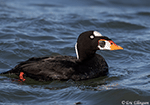 |
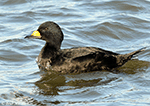 |
| Surf Scoter (male) | Black Scoter (male) |
Conservation Status:
There is some uncertainty over the population trend of the White-winged Scoter, but systematic surveys indicate they are possibly in decline. However, the IUCN considers the White-winged Scoter to be a species of "least concern", as population trends are not currently considered severe enough to warrant a less favorable status.
South Dakota "Hotspot":
White-winged Scoters are very uncommon migrants and winter visitors. They have been found in scattered locations throughout the state, primarily during the fall migration, but by far the most common place to see them is below and near the Missouri River dams. Scan flocks of waterfowl for them at Oahe, Big Bend, Gavin's Point, and Fort Randall dams.
Further Information:
Photo Information:
Taken in Blaine, Washington -- October 2019 -- Mick Thompson
Audio Credits:
- 1Andrew Spencer. Recorded in the Northwest Territories of Canada on June 8th, 2014. Original recording and information are available from xeno-canto.
| Click on the range map for a higher-resolution view |
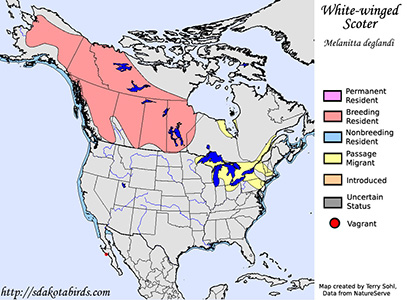 |
| South Dakota Status: Casual to accidental in migration and in winter. |
Additional White-winged Scoter Photos
